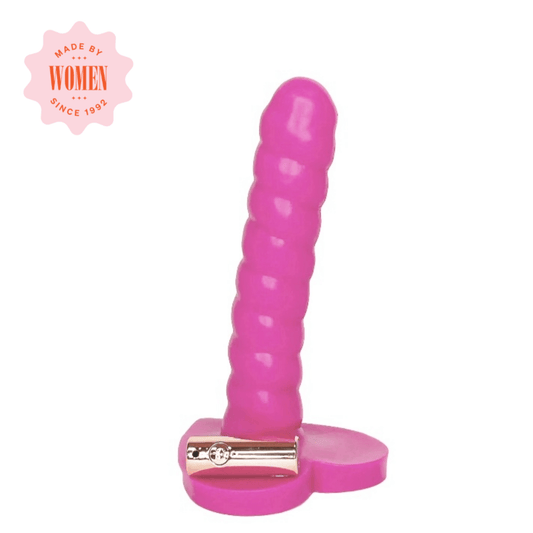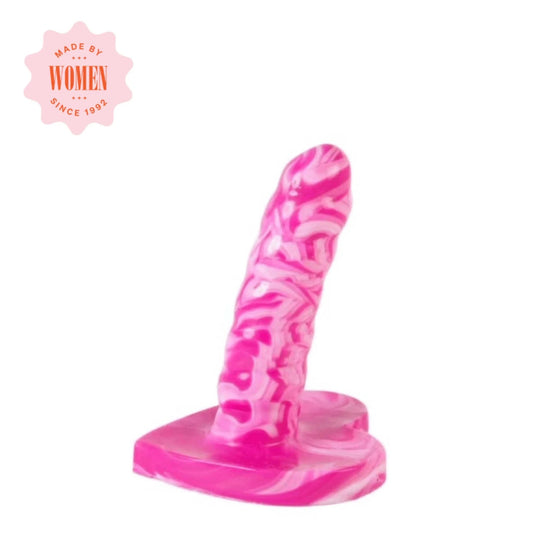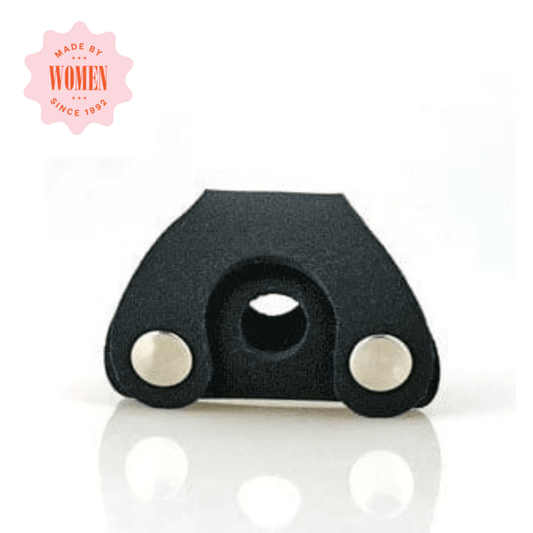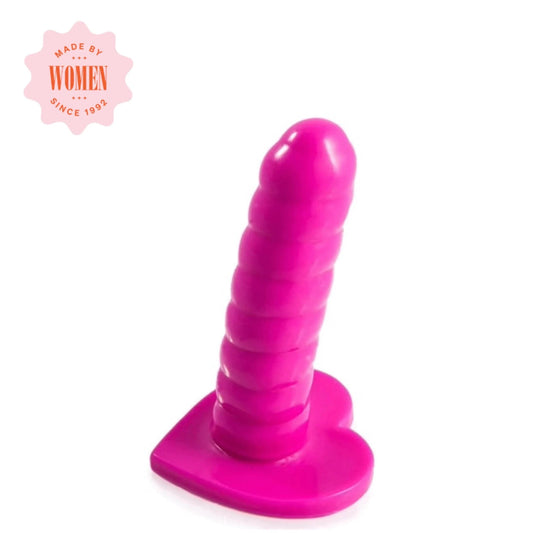When shopping for a dildo, size and shape matter - but have you considered the material? The right sex toy material can make all the difference in comfort, body safety, and pleasure. From silky-smooth silicone to questionable jelly, not all materials are created equal. Some are body-safe and built to last, while others… well, let's just say they belong in the bin!
Short answer? Silicone reigns supreme, while jelly is a no-go. But there's so much more to explore. With a dildo in your hand, it is easy to feel the difference between different materials. It's harder when shopping online, so keep reading to uncover the best (and worst) dildo materials, and learn how to choose the perfect one for your needs.
What Is The Best Dildo Material?
Silicone is the best dildo material, bar none.
Dildos made from silicone feel dry, smooth and very strokable. Silicone dildos don't smell and quickly warm to body temperature. They're soft and pliable but firm enough to be fit for purpose - very important!
At Sh!, we hand-make silicone dildos. This reduces dildo miles, making them a greener choice compared to buying mass-produced dildos from China. Silicone is an expensive raw material with a time-consuming manufacturing process and sensitivity to environmental conditions. Much like us Brits, silicone is very sensitive to the weather:
- Too hot? Not gonna work.
- Too cold? Nope, the silicone is not having it.
What Is The Most Body-Safe Dildo Material?
Silicone is the most body-safe dildo material. Silicone is latex-free, hypoallergenic, phthalate-free, non-porous, and easy to clean. Silicone dildos can be shared between lovers or pleasure zones (remember to clean in between or cover with a condom). Glass and stainless steel dildos are also body-safe.
Some cheaper sex toy materials are porous, meaning they absorb bodily fluids and lube. Bacteria cling to the pores, often causing Bacterial Vaginosis. For this reason, we recommend covering porous dildos with condoms to keep them bacteria-free. Never double dip (moving it between orifices or lovers) without condoms.
Jelly material often contains potentially carcinogenic phthalates. This is not body-safe, and we don't stock toys made from jelly.
Can I Be Allergic To My Dildo?
It's possible to react to the material of your dildo, especially if you are allergic or sensitive to latex or jelly. For some, it may be an uncomfortable itch or rash, which can be overcome by popping a condom over the dildo if you don't want to upgrade to a better sex toy material. If you are severely allergic, you should avoid these sex toy materials altogether. (Orgasms are fab - but don't put your life on the line!)
Silicone is hypoallergenic and a safer choice. We know a handful of customers who are allergic to silicone, but it's uncommon. Silicone is regarded as the best material for sex toys, and it's what we usually recommend.
How To Best Clean My Dildo?
Dildo materials aren't created equal.
Silicone dildos are easy to clean. Silicone is non-porous, so lube and juices will wash right off. Just spritz with sex toy cleaner and rinse off, or wash with antibacterial hand wash and hot water. This is all you need to keep your BFF squeaky clean. And, if you want a deeper clean, silicone dildos can be sterilised by boiling in a pan for a few minutes.
Some cheaper sex toy materials are porous, meaning they absorb bodily fluids and lube, making thorough cleaning impossible. However much you spray, rub and dry your dildo, it will never be 100% clean. Again, spritz with sex toy cleaner and rinse off, or wash with antibacterial hand wash and hot water and leave to air dry.
Pro tip: Stock up on condoms if you have a dildo made from a porous material.
Porous & Semi-Porous Dildo Materials
What Is Thermoplastic Elastomer (TPE) and Thermoplastic Rubber (TPR)?
TPR/TPE materials are flexible and rubber-like, making them cost-effective for mass production. These toys are often squishy, with varying levels of firmness and flexibility.
Why is TPE and TPR not as good as silicone?
Although TPE/TPR materials are phthalate-free, they are semi-porous. This means that bodily fluids and lube will seep into the tiny pores, making complete cleaning impossible. Dildos from TPE and TPR will never be 100% clean, however carefully you clean them.
It's not unusual for women & vulva owners to develop Bacterial Vaginosis after using TPE or TPR toys. Bacteria cling to the pores of the material, growing and multiplying, and eventually transferring to the vagina where it takes a swipe at the delicate flora. The best way to minimise bacterial risk is by covering your TPE or TPR dildo with a condom.
There can be a smell when TPE/TPR toys first come out of the box, but this wears off once the toy has been aired for a while.
What About Dildos Made From SilaSkin Or CyberSkin?
SilaSkin is a blend of silicone and TPR. This is a soft material without off-gases, oils or phthalates. It offers extreme stretchability, making it a popular material for cock rings.
SilaSkin isn't as durable as silicone and it's more susceptible to interactions with other materials. SilaSkin dildos must be stored away from other sex toy materials.
SilaSkin is porous and incompatible with latex. It's tricky to keep clean and as it reacts with latex, covering it with a condom can negatively affect the material.
Cyberskin is a sex toy material designed to mimic the feel of human skin. Made from a blend of various components, it is a type of thermoplastic. Cyberskin offers a more lifelike sensation compared to silicone and other toy materials.
Are Latex Rubber Dildos Body-Safe?
Rubber dildos are porous, so we don't recommend them for long-term use. Bacteria builds up in the pores of the rubber, and you will probably find yourself with a nasty bout of B-Vag in next to no time. On top of this, rubber dildos feel sticky and give off an unpleasant smell, both of which can be off-putting.
Rubber dildos are firm, dense and heavy - they feel solid. Despite this, the material is easily damaged by sharp nails or harness buckles. Rubber dildos are cheap to produce, but you get what you pay for... We recommend choosing a body-safe silicone dildo instead.
Are Jelly Rubber PVC Dildos Body-Safe?
Dildos made from jelly aren't body-safe. Jelly contains phthalates, a group of chemicals that make the material softer and more pliable. This may sound good if you don't like firmer dildos, but it's the opposite - phthalates are potentially carcinogenic.
Jelly rubber is one of the cheapest dildo materials available. It is soft and flexible but has a strong, unpleasant smell. It tends to smell overwhelmingly toxic as soon as you open the box.
Do you have an old jelly dildo loitering somewhere? Babes, it's time to bin it and treat yourself to a new plaything. Your vagina (or anus) deserves so much better!
Choosing the right dildo material is essential for both pleasure and safety. Opt for body-safe, non-porous materials like silicone, and avoid porous materials like jelly, rubber and TPE/TPR.





















